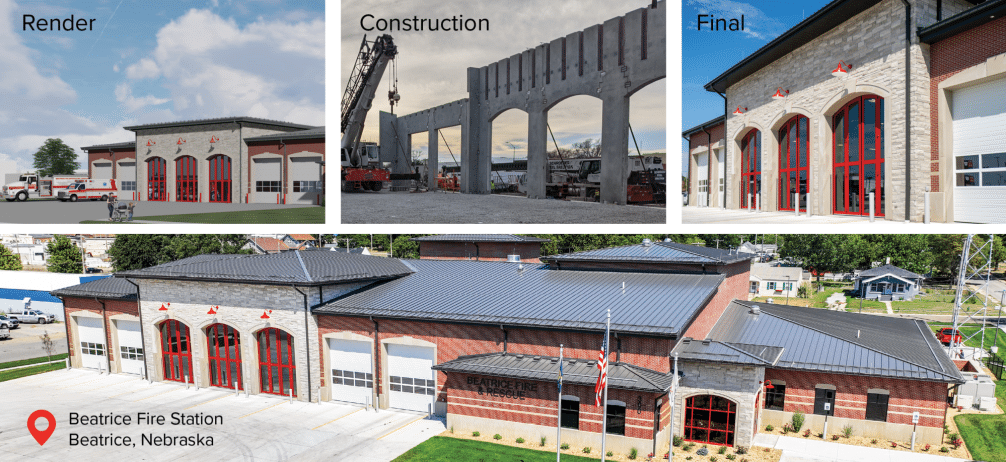Seven Ways Architects Contribute to Building Projects
4/19/2024

So, you’ve decided to build a new space for your company or community. Congratulations! Now what? While the design and construction of a new building or space is rewarding, starting the process can be daunting. Enter the architect. Architects translate vision, ideas, and functional needs into reality, developing construction drawings that enable contractors to successfully construct the project. They advocate for owners during construction ensuring compliance with building material quality and safety standards. We are here to help you learn what architects do and how they contribute to the success of your building projects.
Architects contribute to the success of building projects through seven primary ways:
1. Defining the Project Vision
Architects thrive on bringing your ideas and inspiration to life through buildings. At the onset of a project, they help identify the priorities for a space, develop the user experience, and draw from fundamental design principles to craft a unique solution. Beyond meeting functional requirements, architects help identify and define the vision for the project which can make a lasting impression on those who interact with your building.
2. Synthesizing Design Goals and Budget Constraints
It is critical to design budget-conscious buildings. Architects help identify where your money is best spent to maximize impact on the project and achieve the desired goals. Focusing on two or three feature areas of a project stretches the budget, elevating the design of those spaces. Tasteful, yet economical design decisions can then be made throughout the remainder of the building elevating the aesthetic quality and long-term value of the project.
3. Coordinating Complex Building Systems
Architecture exists at the intersection of art and science. Every aspect of a building, from the exterior materials to the heating and air-conditioning systems, are meticulously planned and specified. Architects serve as the coordinating professional for several disciplines who all work together to create a building. Structural engineers design the bones of the building; mechanical engineers deliver heating, cooling, and plumbing systems; and electrical engineers are responsible for the hidden network of cabling and conduit running through walls and floors of a building providing power and lighting. As coordinating professionals, architects review design goals with their engineering partners to ensure these systems are effectively integrated with the architecture to meet the vision and goals of the project.
4. Interpreting Building Codes and Regulations
New construction and renovation projects must meet various building codes and standards. Building codes protect occupant health, safety, and welfare, while providing functional inclusivity for individuals with disabilities. Throughout the design process, architects meticulously adhere to building codes and regulations, ensuring your space not only passes fire and building inspections but also avoids risk of legal liabilities and potential lawsuits resulting from non-compliance. Examples of applicable codes and regulations include:
- Zoning Regulations
- International Building Code
- Life Safety Code
- International Energy Conservation Code
- Americans with Disabilities Act
5. Supervising Construction
Within construction drawings, architects identify materials and components such as doors, windows, cabinetry, and flooring. As contractors prepare their bid, they often submit requests for material and product alternatives of equal performance, finish, and durability. Contractors submit these requests for a variety of reasons including accessibility, price, or personal preference. Architects review substitution requests, and either approve or deny the proposed alternatives based on your preferences and budget, actively regulating quality of the final build to ensure the product meets your vision. During construction, architects regularly visit the project site verifying construction meets the design intent.
6. Developing Solutions to Unforeseen Challenges
Regardless of document quality, construction projects may encounter unexpected challenges as a project materializes from construction drawings into the real world. When this occurs, architects advise the optimal strategy to maintain your project’s schedule and budget, serving as intermediaries between you and the contractor to ensure changes are successfully implemented.
7. Simplifying the Design and Construction Process
Embarking on a building project can feel like an overwhelming task of seemingly endless choices and decisions. Schedule and budget constraints add anxiety to an already complex process. Architects serve as your guide through the building design and construction process, streamlining decision-making and simplifying complexity for you and your team. They work closely with you to develop the best project from initial concept through construction and celebrate with you during the grand opening.
Building projects make a long-lasting impact in our communities, often serving as a hub of activity and culture. Architects are uniquely situated at the intersection of art and science to lead you through the arduous process of designing buildings. They excel at simplifying complex tasks, communicating abstract ideas in three dimensions, and intricately assembling disparate elements into a cohesive project. The next time you are feeling overwhelmed by a potential building project, look no further than the talented team of architects and designers at JEO.

